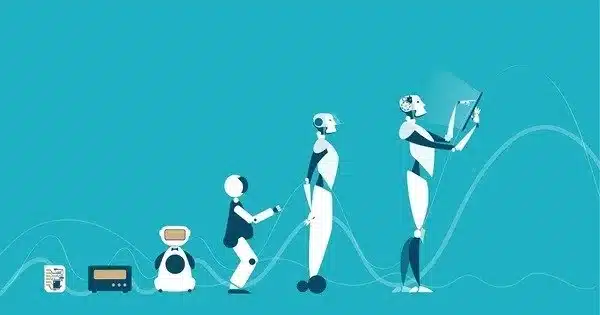Researchers created the first AI capable of intelligently designing robots from the ground up by condensing billions of years of evolution into mere seconds. It is not just fast, but it also works on a lightweight computer and creates entirely new structures from scratch – without the use of human-labeled, biased datasets.
Northwestern University researchers lead the development of the first artificial intelligence (AI) that can intelligently construct robots from scratch.
To put the new AI to the test, the researchers set it a basic task: design a robot that can walk on a level surface. While nature took billions of years to evolve the first walking creature, the new method accelerated evolution to the point where a successful walking robot could be designed in seconds.
However, the AI software is more than just quick. It also works on a small personal computer and creates entirely new structures from scratch. This is in stark contrast to other AI systems, which frequently require power-hungry supercomputers and massive databases. Even after crunching all that data, those systems are bound by the restrictions of human creativity, merely copying humans’ previous works and lacking the potential to produce new ideas.
The findings were reported in the Proceedings of the National Academy of Sciences.
We discovered a very fast AI-driven design algorithm that avoids the traffic jams of evolution while not relying on the bias of human designers. We told the AI that we wanted a land-walking robot. Then we simply hit a button, and voilà! It developed a blueprint for a robot that looks nothing like any animal that has ever walked the earth in the blink of an eye.
Sam Kriegman
“We discovered a very fast AI-driven design algorithm that avoids the traffic jams of evolution while not relying on the bias of human designers,” said Northwestern’s Sam Kriegman, who led the research. “We told the AI that we wanted a land-walking robot. Then we simply hit a button, and voilà! It developed a blueprint for a robot that looks nothing like any animal that has ever walked the earth in the blink of an eye. “I refer to this as ‘instant evolution.'”
Kriegman is an assistant professor of computer science, mechanical engineering, and chemical and biological engineering at Northwestern’s McCormick School of Engineering, where he is a member of the Center for Robotics and Biosystems. David Matthews, a scientist in Kriegman’s laboratory, is the paper’s first author. Kriegman and Matthews worked closely with co-authors Andrew Spielberg and Daniela Rus (Massachusetts Institute of Technology) and Josh Bongard (University of Vermont) for several years before their breakthrough discovery.
From xenobots to new organisms
Kriegman received great media attention in early 2020 for producing xenobots, the first living robots built entirely of biological cells. Kriegman and his colleagues saw their new AI as the next step in their effort to investigate the potential of artificial life. The robot is inconspicuous, being small, squishy, and malformed. And, for the time being, it is made of inorganic components. However, Kriegman believes it is the first step toward a new era of AI-designed instruments that, like animals, can act directly on the world.
“When people look at this robot, they might see a useless gadget,” said Kriegman. “I see the birth of a brand-new organism.”

Zero to walking within seconds
While the AI program can start with any prompt, Kriegman and his team began with a simple request to design a physical machine capable of walking on land. That’s where the researchers’ input ended and the AI took over.
The computer began with a small block the size of a bar of soap. It could jitter but it couldn’t walk. AI swiftly iterated on the idea, aware that it had not yet achieved its purpose. The AI examined its design, detected weaknesses, and nibbled away at the simulated block to update its structure with each repetition. The virtual robot could eventually bounce in place, hop ahead, and shuffle. Finally, after only nine attempts, it produced a robot capable of walking half its body length per second – roughly half the speed of an ordinary human step.
On a laptop, the entire design process took only 26 seconds, from a shapeless block with no movement to a full-fledged walking robot.
“Now anyone can watch evolution in action as AI generates better and better robot bodies in real time,” Kriegman said. “Evolving robots previously required weeks of trial and error on a supercomputer, and of course before any animals could run, swim or fly around our world, there were billions upon billions of years of trial and error. This is because evolution has no foresight. It cannot see into the future to know if a specific mutation will be beneficial or catastrophic. We found a way to remove this blindfold, thereby compressing billions of years of evolution into an instant.”
Rediscovering legs
Surprisingly, AI came up with the same answer for walking as nature: legs. However, unlike nature’s symmetrical designs, AI took a different method. The end result is a robot with three legs, fins down its back, a flat face, and several holes.
“It’s interesting because we didn’t tell the AI that a robot should have legs,” said Kriegman. “It rediscovered that moving around on land with legs is a good idea. In fact, legged mobility is the most efficient type of terrestrial movement.”
Kriegman and his team utilized the AI-designed robot as a template to determine if the simulated robot might work in real life. They began by 3D printing a model of the negative space surrounding the robot’s body. The mold was then filled with liquid silicone rubber and allowed to set for a few hours. The hardened silicone was spongy and pliable when the crew popped it out of the mold.
It was now time to determine if the robot’s simulated behavior – walking – had been transferred to the physical environment. The researchers inflated the rubber robot torso, causing its three legs to extend. The legs contracted as the air in the robot’s body deflated. By continually pumping air into the robot, it repeatedly expanded then contracted – causing slow but steady locomotion.
Unfamiliar design
While the emergence of legs is understandable, the holes are an odd addition. AI poked holes in seemingly random locations across the robot’s body. Porosity, according to Kriegman, eliminates weight and increases flexibility, allowing the robot to bend its legs for walking.
“We don’t really know what these holes do, but we know that they are important,” he added. “Because when we take them away, the robot either can’t walk anymore or can’t walk as well.”
Overall, Kriegman is impressed and intrigued by the robot’s design, observing that most human-designed robots resemble humans, dogs, or hockey pucks.
“When humans design robots, we tend to design them to look like familiar objects,” says Kriegman. “However, AI has the potential to open up new possibilities and paths forward that humans have never considered.” It has the potential to change the way we think and fantasize. And this could help us address some of our most complex problems.”
















